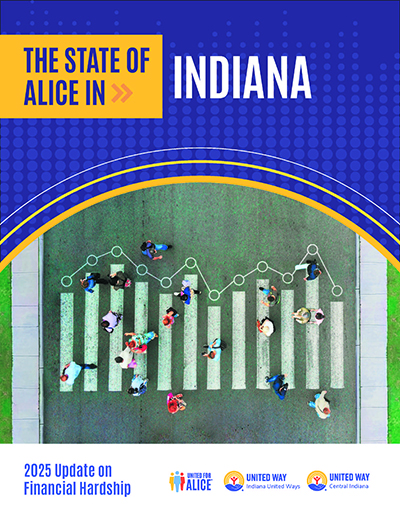
Who is ALICE?
ALICE is an acronym that stands for Asset Limited, Income Constrained, Employed. It refers to households that earn above the Federal Poverty Level (FPL) but cannot afford the basic cost of living in their county. Despite struggling to make ends meet, ALICE households often do not qualify for public assistance.
ALICE in the Crosscurrents: An Update on Financial Hardship in Indiana is brought to you by Indiana United Ways and United Way of Central Indiana in partnership with United for ALICE, a driver of innovative research and action around financial hardship for ALICE households.
To create the ALICE report, a team of researchers worked with a research advisory committee composed of experts from the Family and Social Services Administration (Indiana 211), CSP4Impact, Purpose of Life Ministries, the Paul H. O’Neill School of Public and Environmental Affairs and the Public Policy Institute at Indiana University Bloomington, Black Onyx Management, the Indiana Community Action Poverty Institute, and a consultant specializing in services for health and human services agencies.
The ALICE Household Survival Budget is the foundation of the ALICE research. This budget calculates the bare minimum cost of the household basics needed to live and work in the modern economy by household composition, in every county.

Key Insights from ALICE 2025 Update
- In 2023, over one million households (1,051,031, 38%) across Indiana were below the ALICE Threshold, with 12% of households having income below the Federal Poverty Level (FPL) and an additional 26% with incomes above the FPL but below the real cost to meet their basic needs in Indiana.
- On average, the ALICE Household Survival Budget in Indiana, which reflects the bare minimum cost of household necessities (food, housing, healthcare, childcare, transportation, technology) was $27,696 for a single adult ($13.85/hour) and $74,376 for a family of four with two adults, an infant, and a preschooler ($37.19/hour).
- Across the state, these costs vary from a low of $70,092 per year (Pike County) to a high of $91,680 per year (Hamilton County) for a family of 4, and from a low of $25,536 per year (Sullivan County) to a high of $33,720 per year (Hamilton County) for a single adult household.
- In contrast, the FPL (which is used to qualify families for social supports) is set at $30,000 for a family of four, and $14,580 for a single adult household all all areas of the state, leaving nearly two times as many families struggling to make ends meet despite working hard.
- Between 2010 and 2023, the total number of households in Indiana increased by 10%, the number of households in poverty remained flat, and the number of ALICE households increased by 14%. The number of households with children has declined, while the number of households with individuals age 65+ has increased.
Do I Know Someone Who is ALICE?
- Nearly 1 in 2 workers in these common occupations struggle to meet their basic needs: cooks (45%), personal care aides (44%), fast food and counter workers (41%). Around 1 in 3 people working as nursing assistants (39%), cashiers (39%), healthcare support workers (37%), waiters and waitresses (36%), janitors and building cleaners (35%), laborers and material movers (35%), and stock workers and order fillers (32%). Many of these workers are considered “essential workers” and are our neighbors, family members, and friends.
- Households disproportionately affected include those headed by people under the age of 25 (62%) and age 65 or older (50%), single-parent households (female-headed 73%, male headed (48%), Black (56%) and Hispanic (44%) households, and households in rural areas (40%).
- The cost of essentials has continued to outpace wages.



